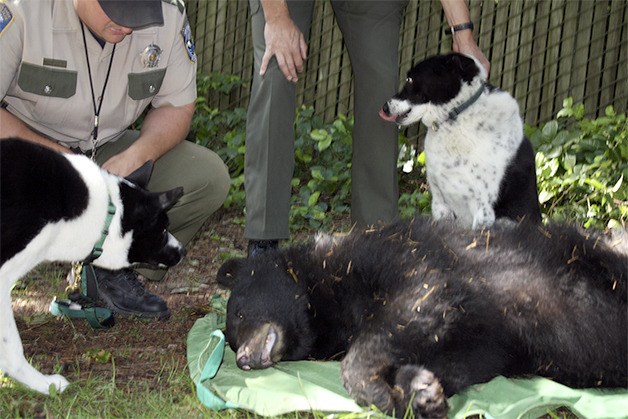If the bear hadn’t busted the fence, there wouldn’t be much to report.
But the black bear that hopped the fence of a residence in the Heights neighborhood of Snoqualmie Ridge in the wee hours last Thursday, Jan. 2, found a small but feisty dog defending the home turf.
The bear turned tail and fled in a hurry. Instead of going back over, he broke bodily through the wood-railed cyclone fence, allowing the dog to chase after.
The encounter, which quickly turned fatal for the little dog, was, in a sense, defensive on the bear’s part.
Chris Moszeter, local enforcement officer for the Washington Department of Fish and Wildlife, believes the black bear retreated about 100 yards into the woods outside the Heights, then decided he’d had enough. He turned and fatally wounded the dog.
After the dog’s death was reported, wildlife officers set a trap nearby. Moszeter baited it with some old Chinese food, vanilla and molasses, stuffed in a sock, then waited.
At least one bear has been spotted around the trap, but so far in the week since the incident, has not gone inside. It may be trap-shy, but Moszeter believes the animal probably hasn’t been trapped before.
“Nobody has seen an ear tag on him,” Moszeter said.
However, bears can sometimes trigger trap-doors without being trapped inside. The noise and force of the door may spook them, and they may remember it long after.
Without success, Moszeter may remove the trap this week. But even if he catches the bear, removing it is no guarantee another bruin won’t move in.
Trash bears
Wildlife officers have trapped four trash bear in the Ridge area in the last three years. There is the possibility that there is more than one bear working the Heights.
Bear sightings happen frequently in Snoqualmie, where an easily accessible food supply—garbage—has created several generations of trash-eating bears.
“Because (of) this huge development, you’ve got bears that have learned that we provide garbage,” Moszeter said. “They teach their cubs.”
In 2012, a Snoqualmie man shot and killed a large, older black bear near his home in The Heights. Also that year, wildlife officers trapped a mother bear and a cub at Lake Alice, later releasing the bear, which moved out of the area.
While bear-vs-dog encounters also happen in the Valley, fatal meetings are rare. Usually, scraps end in both dog and bear fleeing to lick their wounds, Moszeter said.
Bear predation, however, can and does happen. In October, a bear killed a pig and a goat in the neighborhoods below Snoqualmie Casino. That bear was never caught. Moszeter believes it got zapped by an electric fence while foraging in the area, “and hasn’t been back since.”
Dog-bear altercations are often the cause of human bear attacks, when a dog angers a bear, then flees, bringing an angry bear down on its owner.
Local bears don’t hibernate because they don’t have to. The long winter sleep is triggered by a lack of food, and with plenty of garbage to eat, Ridge bears don’t hibernate.
The only way to stop bear incursions on the Ridge’s wilderness-fringe neighborhoods is by removing their food source—easily accessible trash.
“Even if we took every bear out of their right now, and relocate them, and they stayed away—we’re going to have more bears there,” due to the garbage, Moszeter said. “It’s guaranteed.”
However, a routine patrol of the Heights last Sunday showed Moszeter that more and more residents are keeping garbage inside before trash day. He only counted three cans outside.
And with smaller bear-proof garbage cans available now, he sees progress on the trash front.
“If we can get these bear-proof cans to the places that need it most, and get that fringe locked down, you’re going to see our bear conflict numbers drop,” he said. “This becomes a model for other areas.”



